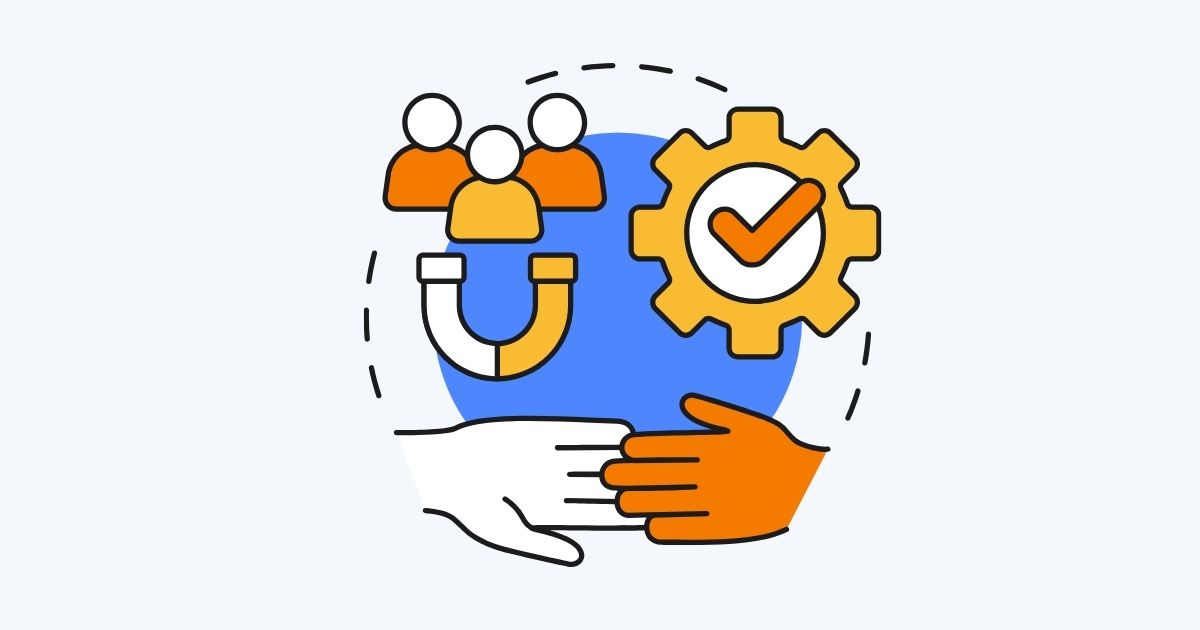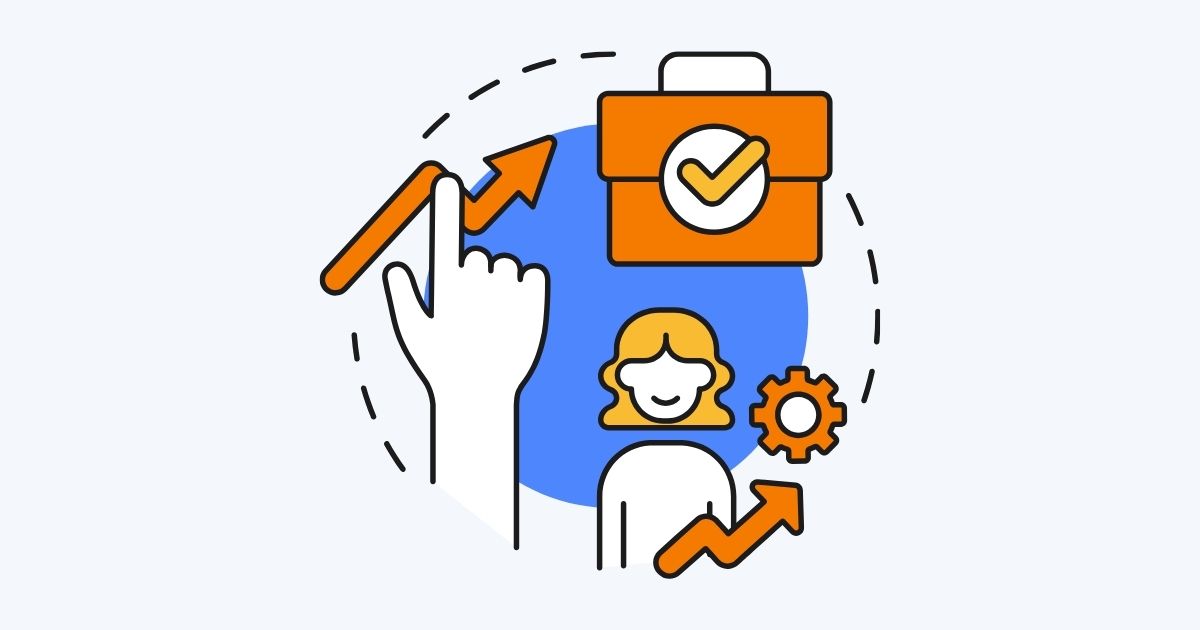While attracting new customers is undoubtedly crucial, the real magic happens when businesses successfully retain their existing clientele.
This brings us to a metric that lies at the heart of customer-centric strategies – the Customer Retention Rate (CRR).
Let’s talk about the CRR and learn the reasons why businesses should prioritize it in their growth strategies.
What is the Customer Retention Rate?
At its core, the CRR is a metric that gauges the percentage of customers a business retains over a specific period.
It is not merely a statistic. It is a reflection of a company’s ability to foster lasting relationships, build loyalty, and create a sustainable customer base.
Picture it as a loyalty indicator – a numerical reflection of a business’s proficiency in keeping its existing customer base satisfied.
Why is Customer Retention Rate Crucial for Business Sustainability?
The CRR is crucial for business sustainability for several key reasons:
1. Predictable Revenue: Loyal customers are more likely to make repeat purchases, providing a more stable and predictable revenue stream.
This consistency in revenue is vital for long-term planning and sustainability.
2. Loyalty and Advocacy: Satisfied, retained customers are more likely to become loyal to a brand.
Loyal customers not only continue to purchase but also become advocates, promoting the business through word of mouth and positive reviews.
3. Customer Lifetime Value (CLV): Retained customers contribute more to the overall profitability of a business over time.
By increasing the CLV, businesses can maximize the return on their initial customer acquisition investment.
The Customer Retention Rate speaks to the long-term viability and resilience of a business in a competitive landscape, making it a cornerstone for sustained success.
What Defines a Healthy Customer Retention Rate for Different Industries?
Businesses need to assess their customer retention rates in the context of their industry, considering factors like
- Purchase frequency
- Customer loyalty programs
- The nature of the products or services offered
Subscription-Based Services
Healthy Range: 90% and above.
Subscription services, like streaming platforms or software subscriptions, often aim for exceptionally high retention rates since their revenue is dependent on recurring payments.
E-commerce
Healthy Range: 20% – 40%.
E-commerce businesses may have a lower CRR due to the nature of one-time purchases. However, cultivating repeat customers through loyalty programs can enhance retention.
Telecommunications
Healthy Range: 75% and above.
Telecommunications companies often strive for high retention rates given the competitive nature of the industry. Offering attractive bundles, and excellent customer service contribute to retention.
Finance and Banking
Healthy Range: 78% and above.
Trust and reliability are paramount in the financial sector. High retention rates indicate customer satisfaction and confidence in the institution. Personalized financial services can enhance retention.
Media companies
Healthy Range: 84%.
The media industry stands out as a global leader in customer retention rates. Media companies, equipped with substantial marketing budgets, leverage their resources to reach expansive client bases.
Remarkably, this strategic outreach contributes to maintaining a robust retention rate even in the absence of extensive personalization efforts.
How Can a High Customer Retention Rate Impact Revenue Growth?
Explore how nurturing existing customer relationships can actively fuel your business’s financial success:
1. Cost-Efficiency: Acquiring new customers typically involves significant marketing and operational expenses.
Retaining existing customers is often more cost-effective as the business has already invested in building a relationship with them.
2. Upselling and Cross-Selling Opportunities: Loyal customers are more receptive to additional offerings. A satisfied client base is likely to explore and purchase new products or services you introduce.
This opens avenues for upselling and cross-selling, directly impacting the average transaction value and, consequently, your overall revenue.
3. Word-of-Mouth Marketing: Happy customers are your best advocates. A high CRR often translates into positive word-of-mouth marketing.
Happy clients are inclined to refer to your business, attracting new customers and boosting revenue without extra marketing expenses.
4. Adaptability to Market Changes: In times of economic uncertainty or market fluctuations, businesses with a strong base of loyal customers are better positioned to weather challenges.
Repeat business from loyal customers can provide a buffer against external shocks.
What Customer Metrics Are Essential for Accurate Retention Rate Calculation?
In addition to the Customer Retention Rate, here are key metrics to consider:
1. Churn Rate
The churn rate represents the percentage of customers who have stopped using a product or service during a specific time period.
Calculation: Churn Rate = (Customers Lost during a Period / Total Customers at the Start of the Period) x 100.
High churn rates can indicate dissatisfaction or issues with your product/service.
2. Customer Lifetime Value (CLV)
CLV is the expected net profit earned from a customer over their entire customer lifecycle.
Calculation: CLV = (Average Purchase Value x Purchase Frequency x Customer Lifespan).
CLV helps gauge the long-term value of customers, guiding decisions on resource allocation for customer retention efforts.
3. Net Promoter Score (NPS)
NPS measures customers’ likelihood to recommend a product or service to others.
Calculation: Based on a single survey question: “On a scale of 0 to 10, how likely are you to recommend our product/service to a friend or colleague?”
NPS provides a qualitative measure of customer satisfaction and loyalty, indicating whether customers are likely to become advocates for your brand.
4. Customer Satisfaction (CSAT) Score
CSAT measures the satisfaction level of customers with a specific interaction or overall experience.
Calculation: Typically based on a survey question like, “How satisfied are you with your experience on a scale of 1 to 5?”
CSAT offers real-time feedback on customer experiences, helping identify areas for improvement and enhancing overall satisfaction for better retention.
5. Repeat Purchase Rate
The repeat purchase rate calculates the percentage of customers who make more than one purchase.
Calculation: Repeat Purchase Rate = (Number of Repeat Customers / Total Customers) x 100.
A high repeat purchase rate signifies customer loyalty and engagement, contributing positively to retention efforts.
By regularly tracking and analyzing these metrics, you can gain a comprehensive understanding of your customer retention performance.
How to Calculate Customer Retention Rate?
With these metrics in hand, you can use the following formula to calculate the Customer Retention Rate:
[(Customers at the End of the Period – New Customers Acquired) / Customers at the Start of the Period] x 100.
Example Scenario
- At the start of the month, your company had 500 customers.
- During the month, you acquired 50 new customers.
- At the end of the month, you had a total of 480 customers.
Calculation
- Retention Rate = ((Customers at the End – New Customers Acquired) / Customers at the Start) × 100
- Retention Rate = ((480 – 50) / 500) × 100
- Retention Rate = (430 / 500) × 100
- Retention Rate = 0.86 × 100
- Retention Rate = 86%
Are There Industry Best Practices for Improving Customer Retention Rates?
Here are some strategies to enhance customer retention:
1. Actively Seek Customer Feedback
Regularly solicit insights from your customers through:
- Surveys
- Reviews
- Direct interactions
This proactive approach allows you to understand customer needs and preferences, enabling you to tailor your products and services accordingly.
2. Keep Customers Informed About Offerings
Maintain open communication channels to keep customers updated on:
- New features
- Product/service updates, or any relevant offerings
Proactive communication demonstrates your commitment to customer satisfaction and fosters brand loyalty.
3. Encourage Word-of-Mouth Advocacy
Inspire satisfied customers to become brand advocates.
Implement referral programs that offer incentives, encouraging customers to share positive experiences and recommendations with others.
4. Prioritize Empathetic Customer Service
Make empathy a cornerstone of your customer service approach. Address customer concerns promptly and with understanding.
An empathetic customer service experience not only resolves issues but also builds a positive emotional connection with your brand.
5. Develop Indispensable Value
Create unique value propositions that differentiate your brand.
Provide exclusive benefits, personalized experiences, or loyalty programs that make it challenging for customers to find alternatives, establishing your brand as indispensable.
Final words
Customer retention is a pivotal factor in the sustained success of any business. By actively seeking customer feedback, encouraging word-of-mouth advocacy, and more, you can build a robust retention strategy.
Before concluding, keep in mind that understanding the industry-specific benchmarks for customer retention rates is crucial.
For a comprehensive solution to enhance your customer retention strategies, consider Call Center Studio.
Our Customer Experience Software covers crucial aspects like CRM, omnichannel customer service, and feedback management. Leverage customer experience analytics to gain valuable insights and improve the customer journey.
In this way, you can increase your CRR, leading to predictable revenue, and a strong foundation for business growth.






